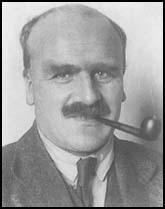A wikipedia of Dr. D'Adamo's research
See Also
IntroductionJohn Burdon Sanderson Haldane (November 5, 1892 - December 1, 1964), who normally used "J.B.S." as a first name, was a British geneticist and evolutionary biologist. He was one of the founders (along with Ronald Fisher and Sewall Wright) of population genetics.
BiographyHaldane was born in Edinburgh, the son of the physiologist John Scott Haldane and his wife Louisa Kathleen Haldane, and descended from Scottish aristocrats (see Haldane family). His younger sister Naomi Mitchison would later become a writer. Haldane was educated at Dragon School, Eton College (which he hated) and at New College, Oxford. During the First World War, Haldane served with the Black Watch in France and Iraq. He was initially Bombing Officer for the 3rd Battalion before becoming a Trench Mortar Officer in the 1st. Whilst in the army, he became a socialist, writing "If I live to see an England in which socialism has made the occupation of a grocer as honourable as that of a soldier, I shall die happy". Between 1919 and 1922 he was a fellow of New College, then moved to Cambridge University until 1932. He then moved to University College, London where he spent most of the remainder of his academic career. In the late 1950s he moved to India. The move was ostensibly a protest against the Suez War, but in reality had been on the cards for some while. In 1924 Haldane met Charlotte Burghes (nee Franken) and the two later married. To do so Charlotte divorced her husband Jack Burghes, causing some controversy. In 1925, Briggs and Haldane gave a mathematically superior derivation of the 1913 Michaelis-Menten equation, still a mainstay of enzyme kinetics in biochemistry. The original authors made the assumption that enzyme (catalyst) and substrate (reactant) are in quasi-equilibrium with their complex, which then dissociates to yield product and free enzyme. Briggs and Haldane arrived at an equation of the same algebraic form, but with a better interpretation of the Michaelis constant. Their derivation makes the more realistic assumption that the intermediate complex(es) are initially in a quasi-steady-state as substrate is consumed and product is formed. He made many contributions to human genetics and was one of the three major figures in the development of the mathematical theory of population genetics. He is usually regarded as the third of these in importance, after R. A. Fisher and Sewall Wright. His greatest contribution was in a series of papers on "A Mathematical Theory of Natural and Artificial Selection" which was the major series of papers on the mathematical theory of natural selection. It treated many major cases for the first time, showing the direction and rates of changes of gene frequencies. It also pioneered in investigating the interaction of natural selection with mutation and with migration. Haldane's book, The Causes of Evolution (1932), summarized these results, especially in its extensive appendix. This body of work was a major component of what came to be known as the "modern evolutionary synthesis", reestablishing natural selection as the premier mechanism of evolution by explaining it in terms of the mathematical consequences of Mendelian genetics. Haldane made many other contributions to theoretical population genetics and statistical human genetics, including the first methods using maximum likelihood for estimation of human linkage maps, and pioneering methods for estimating human mutation rates. His was the first calculation of the mutational load caused by recurring mutations at a gene, and he was first to calculate a "cost of natural selection". Haldane was a keen experimenter, willing to expose himself to danger to obtain data. One experiment involving elevated levels of oxygen saturation triggered a fit which resulted in him suffering crushed vertebrae. In his decompression chamber experiments, he and his volunteers suffered perforated eardrums, but, as Haldane stated in What is Life, "the drum generally heals up; and if a hole remains in it, although one is somewhat deaf, one can blow tobacco smoke out of the ear in question, which is a social accomplishment." He was also a great science populariser, and was perhaps the Isaac Asimov, Stephen Jay Gould, or Richard Dawkins of his day. His essay, 'Daedalus or Science and the Future' (1923), was remarkable in predicting many scientific advances but has been criticized for presenting a too idealistic view of scientific progress. Haldane was himself a very idealistic man, and in his youth was a devoted Communist and author of many articles in The Daily Worker. Events in the Soviet Union, such as the rise of the anti-Mendelian agronomist Trofim Lysenko and the crimes of Stalin, caused him to break with the Communist Party later in life. He joined the Communist party in 1937 but left in 1950, shortly after having toyed with standing for Parliament as a Communist Party candidate. He is also known for an observation from his essay, On Being the Right Size, which Jane Jacobs and others have since referred to as Haldane's principle. This is that sheer size very often defines what bodily equipment an animal must have: "Insects, being so small, do not have oxygen-carrying bloodstreams. What little oxygen their cells require can be absorbed by simple diffusion of air through their bodies. But being larger means an animal must take on complicated oxygen pumping and distributing systems to reach all the cells." The conceptual metaphor to animal body complexity has been of use in energy economics and secession ideas. Haldane was friends with the author Aldous Huxley, and was the basis for the biologist Shearwater in Huxley's novel Antic Hay. Ideas from Haldane's Daedalus, such as ectogenesis (the development of fetuses in artificial wombs), also influenced Huxley's Brave New World. Haldane had many students, the most famous of whom, John Maynard Smith, was perhaps also the one most like himself. Haldane was diagnosed with rectal cancer in the early 1960s, and bore the news with characteristic fortitude and a wickedly grim sense of humour. He composed a poem called "Cancer's a Funny Thing", which commenced: I wish I had the voice of Homer LinksAttribution
|
COMPLETE BLOOD TYPE ENCYCLOPEDIA
The Complete Blood Type Encyclopedia is the essential desk reference for Dr. D'Adamo's work. This is the first book to draw on the thousands of medical studies proving the connection between blood type and disease. Click to learn more
Click the Play button to hear to Dr. Peter J. D'Adamo discuss .
|
The statements made on our websites have not been evaluated by the FDA (U.S. Food & Drug Administration).
Our products and services are not intended to diagnose, cure or prevent any disease. If a condition persists, please contact your physician.
Copyright © 2015-2023, Hoop-A-Joop, LLC, Inc. All Rights Reserved. Log In
